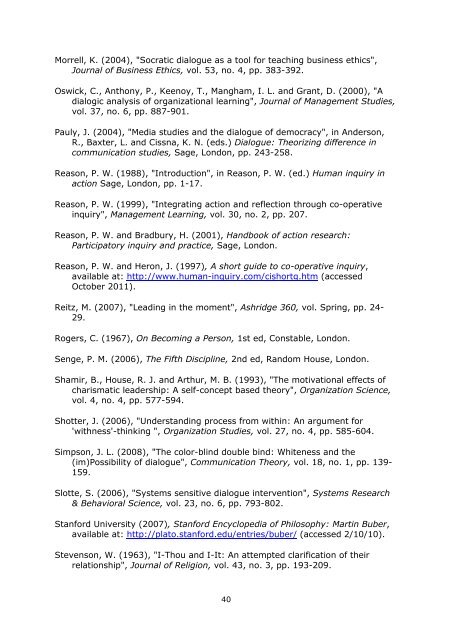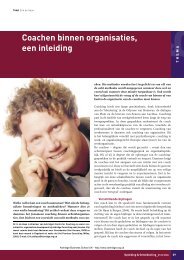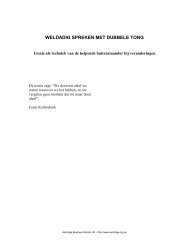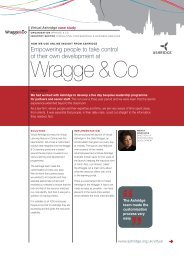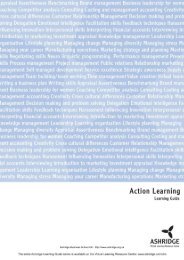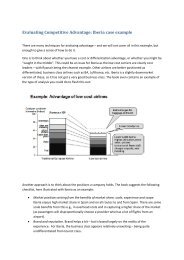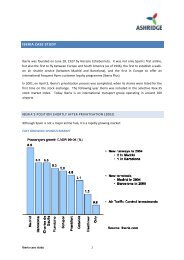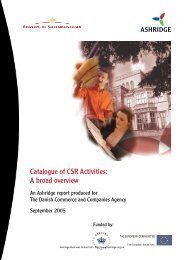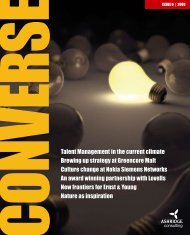“Dialogue – possible between leader and follower?” - Ashridge
“Dialogue – possible between leader and follower?” - Ashridge
“Dialogue – possible between leader and follower?” - Ashridge
Create successful ePaper yourself
Turn your PDF publications into a flip-book with our unique Google optimized e-Paper software.
Morrell, K. (2004), "Socratic dialogue as a tool for teaching business ethics",<br />
Journal of Business Ethics, vol. 53, no. 4, pp. 383-392.<br />
Oswick, C., Anthony, P., Keenoy, T., Mangham, I. L. <strong>and</strong> Grant, D. (2000), "A<br />
dialogic analysis of organizational learning", Journal of Management Studies,<br />
vol. 37, no. 6, pp. 887-901.<br />
Pauly, J. (2004), "Media studies <strong>and</strong> the dialogue of democracy", in Anderson,<br />
R., Baxter, L. <strong>and</strong> Cissna, K. N. (eds.) Dialogue: Theorizing difference in<br />
communication studies, Sage, London, pp. 243-258.<br />
Reason, P. W. (1988), "Introduction", in Reason, P. W. (ed.) Human inquiry in<br />
action Sage, London, pp. 1-17.<br />
Reason, P. W. (1999), "Integrating action <strong>and</strong> reflection through co-operative<br />
inquiry", Management Learning, vol. 30, no. 2, pp. 207.<br />
Reason, P. W. <strong>and</strong> Bradbury, H. (2001), H<strong>and</strong>book of action research:<br />
Participatory inquiry <strong>and</strong> practice, Sage, London.<br />
Reason, P. W. <strong>and</strong> Heron, J. (1997), A short guide to co-operative inquiry,<br />
available at: http://www.human-inquiry.com/cishortg.htm (accessed<br />
October 2011).<br />
Reitz, M. (2007), "Leading in the moment", <strong>Ashridge</strong> 360, vol. Spring, pp. 24-<br />
29.<br />
Rogers, C. (1967), On Becoming a Person, 1st ed, Constable, London.<br />
Senge, P. M. (2006), The Fifth Discipline, 2nd ed, R<strong>and</strong>om House, London.<br />
Shamir, B., House, R. J. <strong>and</strong> Arthur, M. B. (1993), "The motivational effects of<br />
charismatic <strong>leader</strong>ship: A self-concept based theory", Organization Science,<br />
vol. 4, no. 4, pp. 577-594.<br />
Shotter, J. (2006), "Underst<strong>and</strong>ing process from within: An argument for<br />
'withness'-thinking ", Organization Studies, vol. 27, no. 4, pp. 585-604.<br />
Simpson, J. L. (2008), "The color-blind double bind: Whiteness <strong>and</strong> the<br />
(im)Possibility of dialogue", Communication Theory, vol. 18, no. 1, pp. 139-<br />
159.<br />
Slotte, S. (2006), "Systems sensitive dialogue intervention", Systems Research<br />
& Behavioral Science, vol. 23, no. 6, pp. 793-802.<br />
Stanford University (2007), Stanford Encyclopedia of Philosophy: Martin Buber,<br />
available at: http://plato.stanford.edu/entries/buber/ (accessed 2/10/10).<br />
Stevenson, W. (1963), "I-Thou <strong>and</strong> I-It: An attempted clarification of their<br />
relationship", Journal of Religion, vol. 43, no. 3, pp. 193-209.<br />
40


